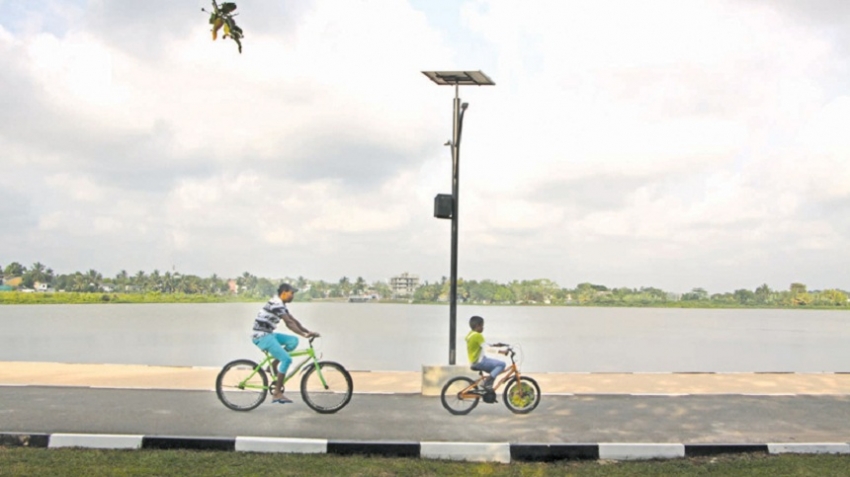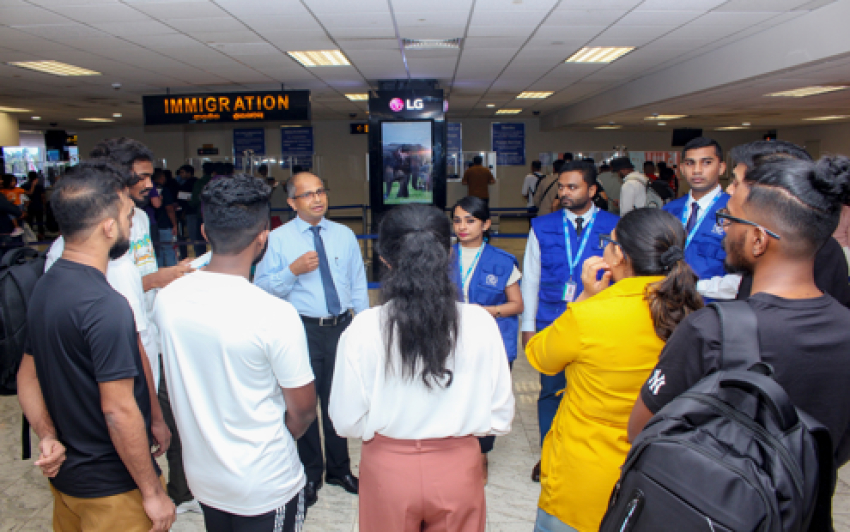60% of the world’s urban population is set to be under 18 by 2030. It will only become more important for our cities to be healthy, safe, and friendly for all ages”.“The proportion of the global population aged 60 will double from 11% in 2006 to 22% by 2050. Currently more than 700 cities in 39 countries are signed up to the World Health Organization’s global network of age-friendly cities and communities to promote healthy active ageing and improve the quality of life for people over 60”.The subject of beautification of cities will assume importance soon, combined with beautification one must develop smarter cities with the caveat, most of our dwellings are not in cities. Development should not create cleavages between those in cities and those in rural settings.
Cities friendly for children and seniors
Making walking routes to school safer for children, for example by having enough pedestrian crossings, makes cities more walk able and accessible for everyone. Creating attractive public space where children and families want to spend time can increase footfall and revenue for local businesses. And making it safer and easier for people of all ages and abilities to walk, cycle, and use public transport can help tackle air pollution, one of the biggest challenges of our time.
At the same time, as cities around the world are growing, their residents are growing older. The proportion of the global population aged 60 will double from 11% in 2006 to 22% by 2050. The physical and social environments are key determinants of whether people can remain healthy, independent and autonomous long into their old age. Currently more than 700 cities in 39 countries are signed up to the World Health Organization’s global network of age-friendly cities and communities to promote healthy active ageing and improve the quality of life for people over 60.
Membership doesn’t necessarily denote an age-friendly city, but that it is committed to listening and working with its older population to create one. Innovative schemes are making cycling more accessible to older people. For those who no longer have the physical ability, Cycling Without Age – piloted in Copenhagen and now in 40 countries – enables the elderly to go out in tricycle rickshaws pedalled by volunteers.
The article today shares how cities around the world have striven to become smart.
Singapore
Unique to Singapore’s smart city plans is the fact that the government is not embracing it as an efficiency campaign, but as an interdisciplinary exercise: becoming a smart city is a way to look at the quality of life in the city, economic growth and human development. Under its Smart Nation Initiative, launched in 2014, Singapore has embarked on strategic national projects that reduce friction between the government, businesses and citizens, improving productivity while paying attention to sustainability. One of the reasons Singapore is so successful is because of the close collaboration between the public and private sectors. Many smart city solutions in Singapore have originated in the private sector, but were tested in the public sector. If the solutions turned out to be successful during the testing rounds, the public sector rolled them out across the city.
Bristol, United Kingdom
With its 442,500 inhabitants and the title European Green Capital 2015, Bristol is named alongside London as the UK’s smart city leaders.
Led by Bristol City Council and partners, the Bristol pilot aims to explore how smart technology could be used to: reduce the cost, and amount of energy consumed to help tackle fuel poverty; use more local clean renewable sources of energy; to increase local resilience; enable greater sustainable mobility to increase; health and well-being, as well as enable better access to training and employment; engage citizens in their energy use and travel patterns to enable them to make the changes they want; contribute to an overall aim to significantly help towards reducing the city’s CO2 emissions.
San Sebastian, Spain
San Sebastian has become one of the leading European cities in the context of smart and sustainable cities, largely because of its commitment to science, technology, economic development, sustainability and culture
The project aims to enhance the transition process to a smart city with the following: energy efficiency: achieve energy savings in relation to the existing situation in retrofitting buildings and in district heating; sustainable mobility: integrate sustainable electric vehicles, recharging systems and an Information Mobility System; integrated ICT infrastructures: develop new sustainable and cost-effective services to citizens providing integrated infrastructures that improve efficiencies in the use of local public resources and the delivery of public services.
Tartu, Estonia
Often called the intellectual capital of Estonia, Tartu is a town of intellectuals, scientists, creatives and students, making it a hotbed for creative and scientific culture.
Also known as the city of good thoughts, Tartu already has a good track record as a smart city. It has been developing its e-services and paperless administration practices for decades and was one of the first in the world to implement many smart solutions – m-parking in 2000, public Wi-Fi throughout the city in 2000, local e-elections in2005, city mobile applications in 2006, digital signatures in 2007, a fully electric taxi service in 2012, and participative budgeting in 2013, to name a few.
Tartu ranks 15th in the European Smart Cities benchmark for smart people and joined the Covenant of Mayors in 2014 with the aim of promoting energy-efficient solutions, the use of renewable energy and citizens’ awareness of environmental issues.
Tartu aims to: demonstrate a comprehensive approach to retrofitting out-dated panel buildings according to near zero-energy standards; boost the livability of the town through intelligent street lighting, biogas buses, electric car and bike rentals, as well as charging stations and many ICT solutions; engage the citizens in creating a high-quality living environment that inspires environmentally aware decisions and new patterns of behaviour.
Lyon, France
Lyon aims to: refurbish 35,000 m2 of existing buildings to reduce their energy consumption; develop local renewable energy generation: photovoltaic systems (1 MWp) and a wood-fired cogeneration power plant (2 MWe/4 MWth); reduce the use of conventional cars by providing alternative means of transport for inhabitants: smart charging stands, an electric vehicle car-sharing system and an autonomous driverless electric shuttle; feed the existing Grand Lyon smart data platform with news set of data to better monitor energy production and consumption in the area, and the actual effects and benefits of measures implemented to reach the zero-carbon objective; involve citizens in the redevelopment of the Lyon Confluence area and the implementation of new services (creation of an urban living lab to allow citizens and users to co-design the smart city solutions); increase the inhabitants’ quality of life through the construction of comfortable and affordable dwellings and offices, convenient public spaces, easy access to the district, etc.
Manchester, United Kingdom
Manchester’s approach is based upon an understanding that cities function as systems, involving a complex interaction between individuals, markets, infrastructure networks and public services. Every individual intervention has been chosen because it demonstrates the benefits of integration in different ways. Manchester’s overall objective is for Corridor Manchester to become one of the largest knowledge-rich low-carbon districts in Europe.
The implemented solution should impact the following targeted aspects: energy use (buildings and transport); energy costs; energy generated from renewable sources; mobility (i.e. reduction of journeys); air quality (reduction of carbon emissions); creation of new jobs; generation of added value (socio-economic impact); improved efficiency of doing business.
Milan, Italy
Milan considers the idea of a smart city as being not technology-driven, but centred on its citizens. The concept ‘smart city’ for Milan covers smart mobility, smart environment and smart inclusion and citizenship.
Milan aims to: aggregate demand and deploy smart city solutions; deliver common and replicable innovative models; attract external investment; accelerate the take-up of smart city solutions; pilot energy-efficient districts; shift thinking irreversibly to local renewable energy sources; promote new models of e-mobility; successfully engage with citizens; exploit ‘city data’ to maximum effect; foster local-level innovation, creating new businesses and jobs.
Lisbon, Portugal
The city aims to become smart, sustainable, competitive, participatory, creative, innovative and citizen-centric. The strategy’s main objectives are to attract more inhabitants by improving the quality of housing, and offering smart living services and smart ageing opportunities; to boost the economy and increase employment by investing in research and development, attracting more entrepreneurs and broadening access to higher education; and improving the quality of life in the city through measures for energy efficiency, mobility and social cohesion. Local regeneration and citizen participation are also priorities.
Sonderborg, Denmark
Sonderborg is a Danish municipality with 76,000 citizens committed to becoming a zero-carbon community by 2029. Based on a baseline assessment of the current situation and an active involvement of citizens in all interventions, the project will implement renovations of multi-storey buildings, planning of coastal wind farms, heat pumps, electric cars and intelligent charging stations for electric cars.
Vienna, Austria
In total, 21,000 inhabitants will benefit from smart project solutions within the fields of refurbishment, energy, mobility, and information and communication technologies.
Impact: refurbish three residential neighbourhoods with 1,300 inhabitants and a total floor surface of 75 000 m2; ensure total savings of 6,000 MWh per year in all the refurbished housing complexes, which corresponds to the energy use of about 700 housing units; guarantee more sustainable and future-oriented energy supply with 9,000 MWh provided by renewable energy sources (thermal as well as electric-energy), which will result in considerable savings for the tenants in energy and heating costs; save about 550 tonnes of CO2 annually; secure and/or create 900 jobs; promote an intensive governance learning process by involving eight departments of the City of Vienna’s administration, ensuring that the experiences and results of the project will be integrated in a sustainable way all over the city.
****
Eight key features of Age-Friendly Cities
* Outdoor spaces and public buildings are pleasant, clean, secure, and physically accessible.
* Public transportation is accessible and affordable.
* Housing is affordable, appropriately located, well built, well designed and secure.
* Opportunities for seniors to participate in leisure, social, cultural and spiritual activities with people of all ages and cultures.
* Aging adults are treated with respect and included in civic life.
* There are opportunities for employment and volunteerism.
* Age-friendly communication and information is available.
* Community support and health is tailored to older persons’ needs.




















